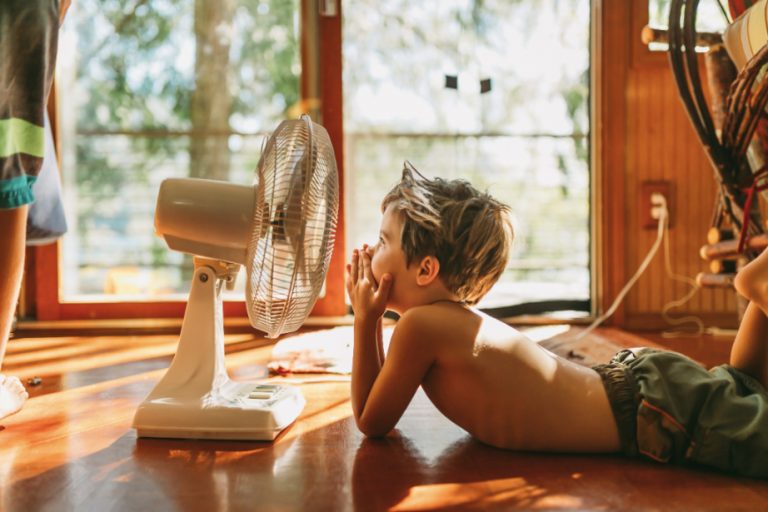With the dog days of summer rolling along, you may find yourself thinking more and more about the benefits of air conditioning.
Maybe you want to keep it simple and buy a window unit, or maybe the one you own isn’t working as well as it did last year. Perhaps the cost of AC in your upcoming electric bill is giving you anxiety.
In this post, we’ll try to get to the bottom of everything you’re wondering about air conditioning. There’s quite a bit to go over, so feel free to skip around to find the information you’re looking for.
Psst … want to learn more about your HVAC and other systems in your home? Check out our breakdown of your home’s electricity, plumbing, and HVAC.
What are the different types of air conditioners?
There are three main types of air conditioners. Though they have different setups, they all use refrigerants, coils, compressors, valves, and fans to collect heat from inside your home and move it outside.
- Window air conditioners (aka “window units” or “room air conditioners”): These fit in either a window frame or a space cut through an exterior wall (from the inside). The fans, coils, refrigerants, valves, and compressors are all packaged into the single unit.
- Central air conditioners: Central air conditioners have two units. One lives inside your home and the other sits outside. Fans blow cooled air through your home via ductwork and vents.
- Ductless air conditioners: Aka “ductless mini-split systems,” ductless air conditioners have a large outdoor unit, and several smaller, wall-mounted indoor units. Instead of using ductwork, the wall-mounted units blow cool air directly into the room.
What’s a BTU? And how many of them do I need?
Air conditioner sizes are measured in BTUs, which stands for “British Thermal Units.” Here’s the equation: 1 BTU = the amount of energy needed to change the temperature of 1 pound of water by 1-degree Fahrenheit. Huh? Don’t worry, you don’t need to memorize that! It’s basically a fancy way of measuring the cooling power of a particular air conditioning unit.
Knowing the BTU equation won’t help you figure out what size AC you need for a room, anyway. A good general room is to aim for 25 BTUs per square foot. For example, a 400-square-foot room would require an AC that puts out 10,000 BTUs. There are also some good calculators and charts out there to help you select the right size, like this one from The Home Depot, and this one from EnergyStar.gov.
Keep in mind, bigger isn’t always better. An air conditioner that is too big for a space can cause the unit to malfunction. It can also cool the air too quickly without removing enough humidity, leaving the room cold and clammy.
What is Energy Star? And what does it mean for my AC?
You know that little blue Energy Star sticker you see on some appliances? It has more meaning than you may think.
Energy Star is a government-backed program founded in 1992. It’s overseen by the U.S. Environmental Protection Agency (EPA) and the U.S. Department of Energy (DOE), with the goal of equipping consumers with understandable and accurate information about the amount of energy different products use.
According to EnergyStar.gov, nine out of 10 Americans recognize the blue energy star label. But what exactly does that little label mean?
The Energy Star label means an appliance met strict energy efficiency standards set by the EPA. Though requirements differ between products, passing the certification is no small feat. The appliances that receive the label have the lowest impact on the environment and save consumers the most money on energy bills.
Air conditioners with the Energy Star label are at least 10% more energy efficient than the minimum efficiency required by law. They also come with features such as energy saver mode and reminders to clean your filter.
How can I cut down the cost of cooling in my utility bills?
When it comes to air conditioners, maintenance and cost-cutting go together like lemons and lemonade. Efficiency is the key to cutting costs. If your unit isn’t properly cared for, it’ll have to work extra hard to cool down your home.
The most important thing you can do is keep your AC filters clean. Here’s a quick breakdown based on the different types of ACs:
- Window units have a filter located behind the grill on the front of the unit.
- Ductless systems have a filter inside each indoor unit.
- Central air systems have a filter inside the indoor unit. They may also have additional filters behind vents in different rooms.
Clean or change filters every one to three months. With reusable filters, use a sponge or wet rag to clean them off, and let them dry before putting them back.
Central air systems commonly have disposable filters. Pro tip: Save money by ordering them by the box.
Keeping the coils clean is another high impact maintenance point. The coils are the part of the air conditioner with thin pieces of metal surrounding them called “fins.” Air needs to be able to get through the fins in order for the refrigerant to absorb and release heat.
Window air conditioners have a coil in the front and back of the unit. In ductless and central air systems, there’s a coil in both the outdoor and indoor units. A vacuum or brush should get the job done. And if you find bent or damaged fins, carefully straighten them. A fin comb is the best way to straighten fins without doing additional damage.
Finally, seal gaps around your windows. Most window ACs come with insulation, but it can wear out over time, especially if you remove your ACs in the winter. If you have double-hung windows, don’t forget about the gap at the top of the lower sash. Use caulking to seal any gaps in the window frames or walls around the windows.
What Kind of Air Conditioner Should I Buy?
There are a few ways to think about this question. First, consider the climate where you live and how much you’ll use the air conditioner throughout the year. Second, think about what kind of system would best fit your home. Then determine your budget.
Let’s take a closer look:
- Climate is the first consideration. In some parts of the country, you may only need air conditioning for a couple of weeks or months in the summer. In this case, a simple window unit or portable air conditioner will probably do the trick.If you live in a region that is warm year-round, a central air system or ductless system may be a better bet. You’ll spend more money upfront, but your system will be more efficient and effective in the long run. And you won’t have units occupying your windows, in case you want to open them on cooler days.
- Your home’s design is important, too. For window units, consider the size and type of windows you have. You can buy ACs that fit various sizes and types of windows, but you may sacrifice power and efficiency. Your home’s layout will also have an impact. For example, if you have an open concept floorplan, a window unit may struggle to cool the wide-open areas inside your home.When it comes to investing in a larger system, consider what kind of HVAC equipment you already own. If you have a furnace with preexisting ductwork, central air may be easier and cheaper than a ductless system. Contractors can often hook it into your furnace ductwork. If you don’t have ductwork, a ductless system might be the way to go. They also offer better zone control, so you can target cooling in specific areas of your home.
- Costs can range drastically between different types of ACs. In a pinch, you can pick up a window air conditioner from a box store for a couple of hundred dollars, or buy a used one for even cheaper. Remember to use the BTU equation above to figure out what size you’ll need. This is the cheapest option, but it’s not necessarily the best.Central air and ductless systems can offer more efficient cooling and more control over cooling in different parts of your home. They’re more expensive upfront, especially if you need to install ductwork, but can save you money and headaches over the long term. According to HomeAdvisor, central air systems typically cost between $1,500 and $4,000. This doesn’t include ductwork or installation costs. For a ductless system, you could pay anywhere between $2,000 to $14,500, depending on the size of your home.If you already have ductwork, a central air system probably makes sense. If you don’t, look into ductless systems. Ductless systems are also more energy-efficient than central air systems because they blow cool air directly into the room, as opposed to moving it through ducts.
While a window unit may not be a big deal, make sure you ask your salesperson or contractor plenty of questions if you’re making a big investment in a central air or ductless. Get a few opinions about what system is right for your home, and compare a few quotes before making the commitment.
A quick note about water
Along with removing heat from the air, air conditioners also remove humidity. As the humid air moves through the AC unit, condensation collects on the coil and drips down to the base. Most ACs have a drain hole or a plastic hose that helps water escape from the unit and drain to the outside of your home.
Water can cause significant damage to your home and result in mold growth. Check around your AC units occasionally to make sure there isn’t any dampness or water.
If you have a window unit that is dripping inside your home, try tipping it more toward the outside. If you have a ductless system or a central air conditioner, make sure any drain hoses aren’t clogged. You should see them in the bottom of the unit. If these solutions don’t work, consider calling in an HVAC professional to take a look.
We hope you enjoyed our ultimate guide to air conditioners! If you’re interested in more home maintenance tips, check out these posts:
- How to build a backyard movie theater for under $100.
- Five easy ways to keep up with kitchen maintenance.




